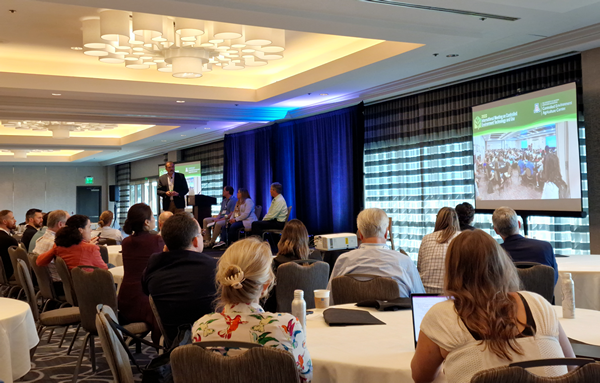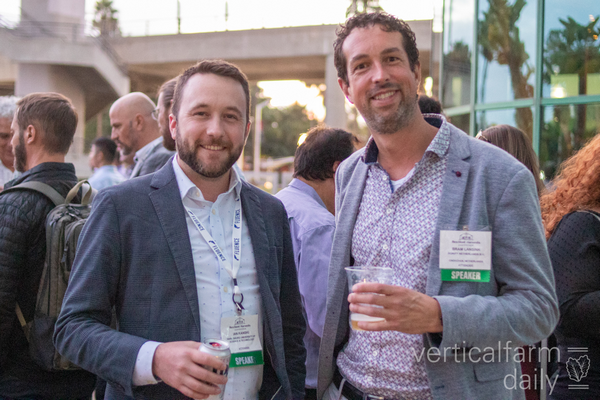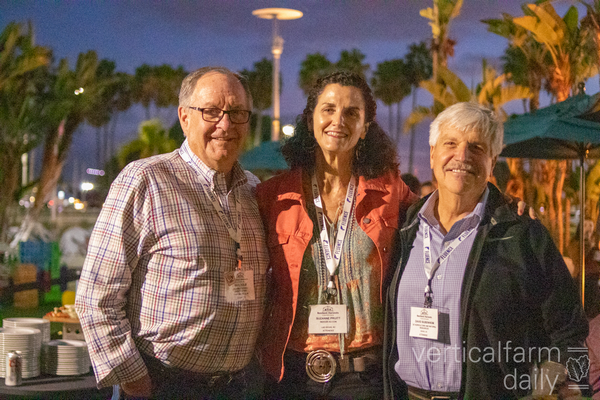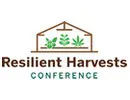After a broad focus on the Southeast market the past week(s), it's now time to zoom in on the US market and beyond. On November 1st, the Resilient Harvests Conference launched its first edition in Long Beach, LA (USA).
At the event, suppliers, agricultural departments, greenhouse- and vertical farm growers, and more came together to sit down and discuss the opportunities, challenges, overlaps, and future of CEA. Closing the day with a fire and a drink, it can be noted that the first day was a success with some interesting and opinionated discussions.

An ongoing panel
During a panel on Regional Policy and program spotlights, which was moderated by Djavid Amidi-Abraham with Agritecture, topics went really broadly into what could be improved in terms of policies, the opportunities ahead, and the struggles. Joining Djavid were Wil Mannes, Program Manager at Colorado Energy Office, Chris Higgins, the owner and President at Hort Americas, LLC, Mike Roth, the Policy Director at Pennsylvania Department of Agriculture, and Tinia Pina, the Founder and CEO of Re-Nuble.
Bridging a gap
Though, going forwards, creating a 'resilient harvest,' Chris Higgins sees some hurdles on the road. He sees two divisions in agriculture across the United States at this point. Namely, the traditional farmers that have been in the business for generations and the ones that are fairly new to the industry with new forms of capital.
"Having these parties working together is really hard as they don't have the time and resources to look into energy savings and navigate these opportunities. Though, the newer agtechs are looking into how to remedy these issues." But, Chris emphasizes that it's so important to have these two groups working together as they are contributing to the agriculture issues we're facing. The only thing is 'a communication gap'.
"Though we have to be careful from a farming standpoint on how much we share because we don't want the public to know everything that is done in farming, take dumping wastewater as an example. We have to navigate it really well," he noted.

Event organizers Mitchell Levin and Sue Ralston with Endeavor Business Media, together with Rebekka Boekhout
The importance of skilled labor opportunities
Although the market is now pushing forward new incentives for agriculture, it is still very hard for companies to hire skilled laborers. That's why Wil Mannes advocates for universities that can create programs, studies, and opportunities in plant science, HVAC knowledge, and more to create talent opportunities for a future skilled workforce for the CEA space.
As labor is seen as a very high cost in CEA, it really becomes a critical piece in capital costs for the sector. That's something the department wants to integrate into the top piece of its newest incentives. "Reducing CapEx in the CEA can be helped alleviate with solar panels, for instance." The department of agriculture has been investing in grants, funds, and more to support CEA, which Pennsylvania will continue to push for sure.
Closing the day with an addition to that, The Hon. US Representative Alan Lowentall noted that renewable energy techniques are coming into the state of California as used in Europe. "The time is now to pivot and start using renewables reducing energy to undergo a critical transition."

After being in a panel together on 'the 5-year Vision for Innovation and Sustainability in Indoor and Greenhouse Farming', Ian Kanski with Harrisburg University of Science and Technology and Bram Lansink with Signify made sure to catch up at the drinks reception
Different landscapes: NYC and California
New York has a different landscape for CEA, according to Tinia Pina, as investors are willing to come at the early risk side, even throughout the early stage of adopting solutions. Tinia explains that it might be because the city prioritizes innovation, adding funding on top of that to scale it even more. Besides that, state programs have been progressively working with utility providers to set up the adoption of incentives proposed which will help to run even more projects across the region.
Pennsylvania incentives
Speaking of opportunities, according to Mike Roth, there are a lot of CEA solutions that can be tapped into for the state government, especially since the climate is worsening, which is making agriculture a tough job for many.
After a day filled with panels, there was a lovely reception at the Hyatt Regency, where everyone enjoyed the California temperatures.
 Elyse Greenberg with Resource Innovation Center who organized this event together with Endeavor Business Media, joined by Bill Brandon with BIEP
Elyse Greenberg with Resource Innovation Center who organized this event together with Endeavor Business Media, joined by Bill Brandon with BIEP

Karl Kolb with HSG/AME certified laboratories, Suzanne Pruitt with Indoor AgCon, and Dacif Bubenheim with UC agriculture and natural resources
 For more information:
For more information:
Mitchell Levin, Event marketing manager
[email protected]
Resilient Harvests Conference
www.resilientharvestsconference.com/2022

Resource Innovation Center
www.resourceinnovation.org
